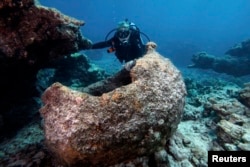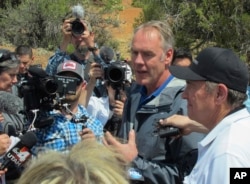U.S. Interior Secretary Ryan Zinke is recommending boundary revisions for some national monuments but no eliminations. President Donald Trump ordered Zinke to conduct an unprecedented review of 27 monuments established by former presidents over more than two decades on lands revered for their natural beauty and historical significance.
Zinke isn't providing details of his plan, beyond proposals disclosed earlier to downsize the Bears Ears monument in Utah and leave six others unchanged. He also says no monuments will be eliminated. Still, any move by Trump to slim down monuments may trigger legal showdowns over whether one chief executive can undo or modify another's decisions about them.
A closer look at the issues:
What is a national monument?
The 1906 Antiquities Act, enacted under President Theodore Roosevelt, empowers the president to declare as national monuments any landmarks, structures and other "objects of historic or scientific interest" on land owned or controlled by the federal government. Roosevelt established 18 monuments, including the Grand Canyon in Arizona and Devil's Tower in Wyoming. Most presidents since then have designated additional monuments. Congress has created others.
Most monuments are overseen by the National Park Service, although rules for their protection are less strict than for national parks. Some are cared for by the federal Bureau of Land Management, the Fish and Wildlife Service or the Forest Service. Each agency has policies for safeguarding the land while also allowing some public use. For instance, policies can include limits on mining, timber cutting and recreational activities such as riding off-road vehicles.
A contentious history
Many national monument proclamations have enjoyed broad support. Others have been fiercely contested in Congress and the courts, including designations by Franklin D. Roosevelt (Jackson Hole National Monument, now Grand Teton National Park); Jimmy Carter (vast lands in Alaska); and George W. Bush (Papahanaumokuakea Marine National Monument northwest of Hawaii).
Trump's choice of January 1, 1996, as the starting date for his review was prompted by lingering resentment among Utah conservatives of Bill Clinton's designation of the Grand Staircase-Escalante National Monument that year.
Critics say presidents increasingly are protecting areas that are too large and do not fit the law's original purpose of shielding particular historical or archaeological sites. Designating millions of acres for scientific observation or sheltering rare species, they contend, is a "federal land grab" that ignores the wishes of local residents, although the lands already belonged to the government or were under federal control.
Zinke says the pendulum has swung too far toward protecting public lands and away from the "multiple-use" concept advanced by Gifford Pinchot, the first chief of the Forest Service and an early leader in the conservation movement.
Monument supporters say the designations are essential to protect sensitive areas from looting and damage. Complaints about people getting kicked off the land are exaggerated, they say, and opposition fades as nearby communities benefit from tourism the monuments attract. A 2014 study by the nonprofit research group Headwaters Economics found that indicators such as employment, population and per capita income held steady or improved in sections of the West where monuments larger than 10,000 acres had been established since 1981.
Legal principles
Some monuments have been downsized over the years, either by presidential order or by Congress, while others have been enlarged. No such actions have been contested in court. No president has tried to revoke a predecessor's designation of a monument. Zinke said he isn't recommending that Trump do so, although Trump could overrule him.
The Antiquities Act does not explicitly say whether a president can nullify a monument proclamation or reduce a monument's area. A legal analysis commissioned by the National Parks Conservation Association cites a 1938 opinion by then-Attorney General Homer Cummings, who wrote that a monument designation has the force of law and can be reversed only by Congress. A House report accompanying the Federal Land Policy and Management Act of 1976 agreed, as do some environmental attorneys.
But a study for the conservative American Enterprise Institute released in March argues that when Congress authorizes the executive branch to write regulations, the power to repeal them generally can be assumed. That's especially so, it says, when a president is correcting a predecessor's act that exceeded what a law intended — such as creating vast monuments when the Antiquities Act says they should consist of "the smallest area compatible with the proper care and management of the objects to be protected."
What's next?
Zinke's report goes to Trump, who will make the final call about whether to change the status of any monuments. Environmental groups and Native American tribes are expected to challenge any eliminations or reductions.
Congressional Republicans have at least five pending bills that would deny the president unilateral authority to designate future monuments, requiring approval of Congress or the governors and legislatures in affected states. Some would add further conditions.









